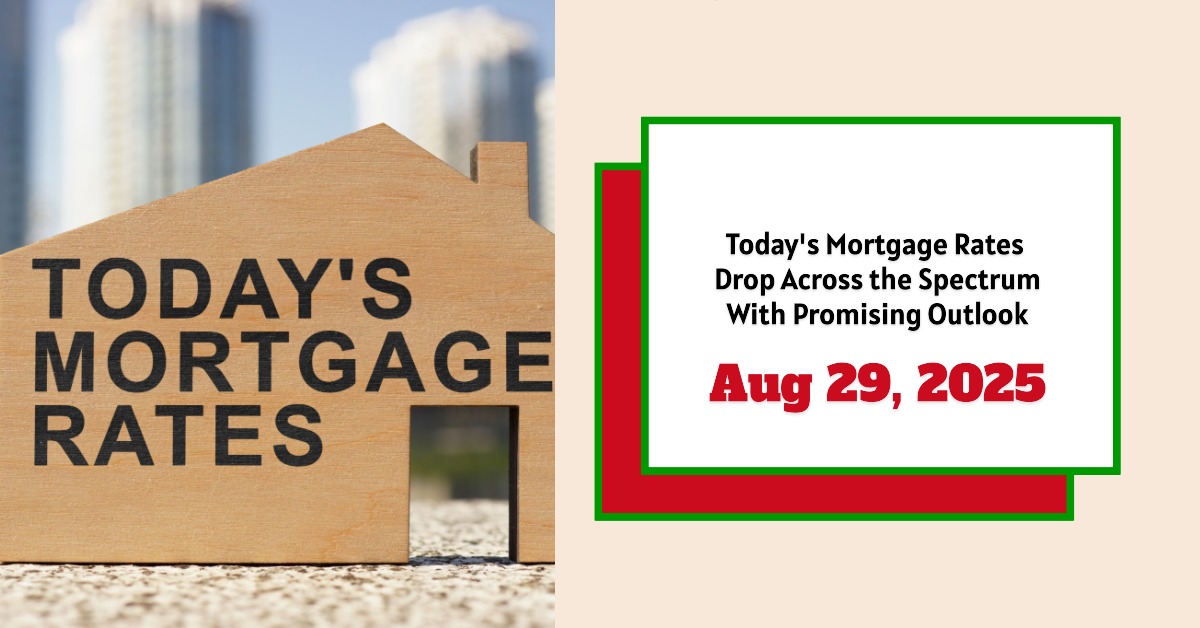If you’re wondering, what are mortgage rates today August 29, 2025? — the short answer is that mortgage rates have decreased across the board this week, with the 30-year fixed mortgage rate slipping slightly to 6.56%, down 11 basis points from last week’s 6.67%. Refinancing rates have also dropped, with the 30-year fixed refinance rate falling to 6.79%.
This downward shift signals a potential easing of borrowing costs, influenced by upcoming Federal Reserve policy moves and economic data showing weak job growth. Locking in a mortgage rate now might be advantageous before rates fluctuate further.
Today's Mortgage Rates – August 29, 2025: Rates Drop Across the Spectrum With Promising Outlook
Key Takeaways
- 30-year fixed mortgage rate drops to 6.56%, a decline of 11 basis points from last week.
- 15-year fixed mortgage rate also falls to 5.59%, marking a 3-basis point decrease.
- 5-year ARM rate drops significantly by 14 basis points to 6.74%.
- Refinance rates drop, with 30-year fixed refinance rate falling to 6.79%.
- Market sentiment predicts a likely Fed rate cut in September 2025, which may push mortgage rates lower.
- Experts expect mortgage rates to hover above 6% through 2025, with only gradual easing into 2026.
- Economic data points to weak job growth and moderate inflation influencing these rate trends.
- The Federal Reserve’s upcoming decisions remain a critical factor in rate movements.
Current Mortgage Rates Today – August 29, 2025
Mortgage rates have moderated a bit this week after remaining somewhat steady in the mid to high 6% range most of the year. Below is the detailed breakdown of rates by loan type from Zillow data:
| Mortgage Type | Current Rate | Change from Last Week | APR | APR Change from Last Week |
|---|---|---|---|---|
| 30-Year Fixed | 6.56% | Down 0.11% | 6.95% | Down 0.17% |
| 20-Year Fixed | 6.23% | Down 0.20% | 6.50% | Down 0.42% |
| 15-Year Fixed | 5.59% | Down 0.18% | 5.84% | Down 0.23% |
| 10-Year Fixed | 5.79% | No Change | 6.09% | No Change |
| 7-Year ARM | 6.94% | Down 0.26% | 7.50% | Down 0.25% |
| 5-Year ARM | 6.74% | Down 0.40% | 7.44% | Down 0.29% |
Government-backed loans have also seen movements:
| Government Loan Type | Current Rate | Change from Last Week | APR | APR Change from Last Week |
|---|---|---|---|---|
| 30-Year Fixed FHA | 5.88% | Down 0.14% | 6.88% | Down 0.15% |
| 30-Year Fixed VA | 6.15% | Down 0.06% | 6.36% | Down 0.06% |
| 15-Year Fixed FHA | 5.49% | Down 0.06% | 6.45% | Down 0.06% |
| 15-Year Fixed VA | 5.90% | Up 0.06% | 6.26% | Up 0.06% |
Last updated August 29, 2025 (Source: Zillow)
Refinance Rates as of August 29, 2025
Refinance rates have also trended downward, though some segments such as the 15-year fixed refinance rate saw modest increases. Here's the latest data from Zillow:
| Refinance Loan Type | Current Rate | Change from Last Week |
|---|---|---|
| 30-Year Fixed Refinance | 6.79% | Down 0.01% |
| 15-Year Fixed Refinance | 5.72% | Up 0.16% |
| 5-Year ARM Refinance | 7.21% | Down 0.04% |
The 30-year fixed refinance rate dropping below 6.8% after hovering near 6.88% last week is a positive sign for homeowners looking to lower monthly payments by refinancing.
What’s Driving Today’s Mortgage Rate Trends?
Understanding why mortgage rates are moving the way they are today requires looking at the broader economic and policy context:
Federal Reserve’s Role and Monetary Policy Impact
The Fed’s monetary policy overwhelmingly influences mortgage rates. After pandemic lows, the Fed raised its benchmark rates aggressively between 2022 and mid-2023 to combat inflation. This caused mortgage rates to soar to levels not seen in nearly 20 years.
Now in 2025, the picture is changing. The Fed has held rates steady over five meetings this year despite economic headwinds such as:
- Rising unemployment: Up to 4.2%.
- Slowing job growth: Recent data indicates weaker employment trends.
- Moderately high inflation: Core inflation remains sticky but is trending closer to the Fed’s 2% target.
The next Federal Reserve meeting on September 16-17, 2025, is widely expected by the market to result in a 25 basis point rate cut. According to CME FedWatch, there is approximately an 89% to 91% chance of this happening, driven by:
- Economic slowdown pressures.
- Weak labor market performance.
- Moderation in inflationary pressures.
If the Fed cuts rates as expected, mortgage rates will likely continue to ease further in the coming weeks and months.
Economic Forecasts and Market Expectations
Economists are cautiously optimistic about the future path of mortgage rates:
- Fannie Mae’s August 2025 forecast predicts median mortgage rates will hover around 6.5% for the remainder of 2025 and drop to about 6.1% in 2026.
- The Mortgage Bankers Association (MBA) expects rates to mostly remain near 6.8% through September 2025, easing slightly afterward.
- Realtor.com projects average mortgage rates might drop to near 6.4% by year-end 2025.
This forecast called by experts reflects that while some relief is on the horizon, mortgage rates are likely to stay above 6% for most of 2025 due to persistent inflation concerns and the Fed’s cautious stance.
Example Mortgage Calculation: How Much Could Your Monthly Payment Change?
To illustrate the impact of today’s rates versus just last week:
Imagine a borrower looking to take a $350,000 mortgage on a 30-year fixed loan.
- At last week's rate of 6.67%, the monthly principal and interest payment would be approximately $2,236.
- At today's rate of 6.56%, it drops to roughly $2,218.
Difference: About $18 less per month, or $216 savings annually—not huge, but meaningful over time.
If the Fed cuts rates in September and mortgage rates drop to near 6.1%, the same mortgage payment could fall closer to $2,120 monthly, a roughly $116 monthly savings compared to today.
Why Rates Fluctuate: Factors At Play
- Inflation: Mortgage rates tend to rise when inflation is high because lenders demand higher returns to offset price increases.
- Employment Data: Strong job growth encourages rate hikes; weak growth can signal rate cuts.
- Federal Reserve Actions: Fed’s interest rate decisions drive bond yields that mortgage rates typically follow.
- Housing Market Activity: Demand for mortgages affects rates indirectly; lower demand can press rates downward.
- Bond Markets: Treasury yields closely track mortgage rates; falling yields usually mean falling mortgage rates.
The recent weak job reports and slightly softened inflation data have created an environment ripe for lower rates.
Related Topics:
Mortgage Rates Trends as of August 28, 2025
Mortgage Rates Predictions Next 90 Days: August to October 2025
Mortgage Rate Trends Compared to Historical Context
To put today's mortgage rates into perspective:
- In 2020 during the COVID-19 pandemic, rates fell below 3% for 30-year fixed mortgages—historic lows.
- By 2023, rates had climbed above 7% due to aggressive Fed rate hikes.
- Today’s rates near 6.5% represent a slow decline from the 7%+ territory but still significantly higher than the pandemic lows.
This shows the market is transitioning but not back to the rock-bottom rates seen earlier in the decade.
Summary Table: Mortgage vs. Refinance Rates (August 29, 2025)
| Loan Type | Mortgage Rate | Change from Last Week | Refinance Rate | Change from Last Week |
|---|---|---|---|---|
| 30-Year Fixed | 6.56% | Down 0.11% | 6.79% | Down 0.01% |
| 15-Year Fixed | 5.59% | Down 0.03% | 5.72% | Up 0.16% |
| 5-Year ARM | 6.74% | Down 0.14% | 7.21% | Down 0.04% |
Personal Reflections and Insight
From my experience and analysis, the current mortgage rate environment reflects how interconnected the U.S. economy is with Federal Reserve policy and global uncertainty. While these rates remain elevated compared to the past decade, the signs of slowdown in economic growth and inflation containment offer potential relief in the short term.
Borrowers should watch the September Federal Reserve meeting closely as it might mark the beginning of a trend toward more affordable borrowing. However, mortgage rates are unlikely to fall dramatically overnight and will probably stay above historical lows for the foreseeable future.
The slight decreases in rates this week, though numerically modest, represent an important psychological shift in the market sentiment, encouraging cautious optimism among borrowers and lenders alike.
Capitalize Amid Rising Mortgage Rates
With mortgage rates expected to remain high in 2025, it’s more important than ever to focus on strategic real estate investments that offer stability and passive income.
Norada delivers turnkey rental properties in resilient markets—helping you build steady cash flow and protect your wealth from borrowing cost volatility.
HOT NEW LISTINGS JUST ADDED!
Speak with a seasoned Norada investment counselor today (No Obligation):
(800) 611‑3060
Also Read:
- Will Mortgage Rates Go Down in 2025: Morgan Stanley's Forecast
- Mortgage Rate Predictions 2025 from 4 Leading Housing Experts
- Mortgage Rate Predictions for the Next 3 Years: 2026, 2027, 2028
- 30-Year Fixed Mortgage Rate Forecast for the Next 5 Years
- 15-Year Fixed Mortgage Rate Predictions for Next 5 Years: 2025-2029
- Will Mortgage Rates Ever Be 3% Again in the Future?
- Mortgage Rates Predictions for Next 2 Years
- Mortgage Rate Predictions for Next 5 Years
- Mortgage Rate Predictions: Why 2% and 3% Rates are Out of Reach
- How Lower Mortgage Rates Can Save You Thousands?
- How to Get a Low Mortgage Interest Rate?
- Will Mortgage Rates Ever Be 4% Again?



